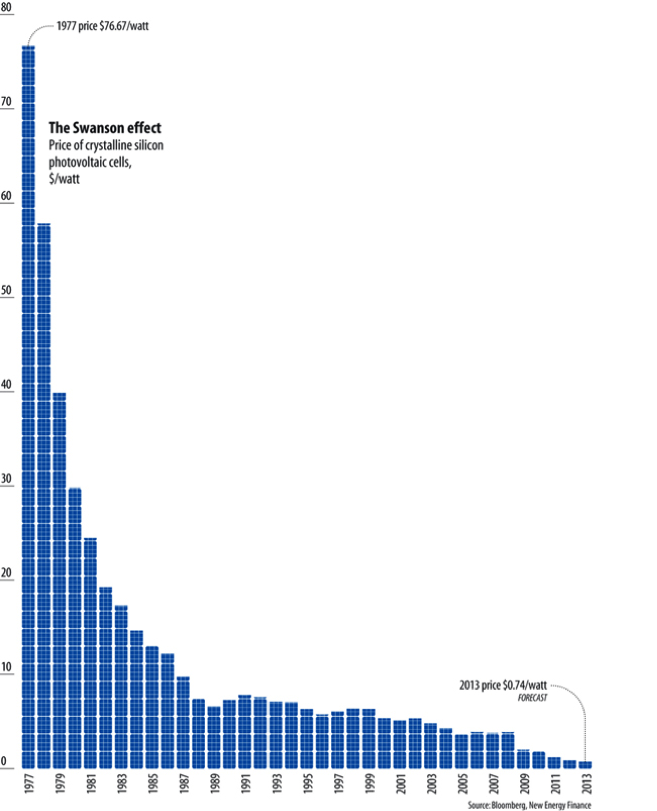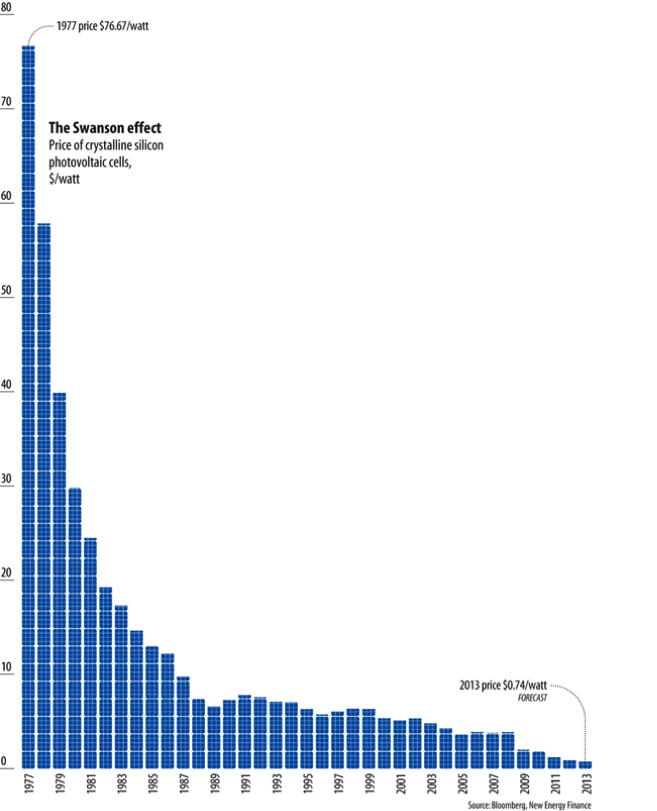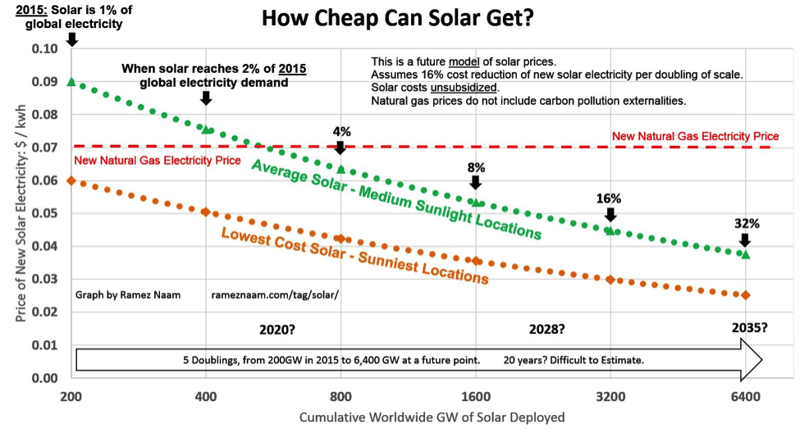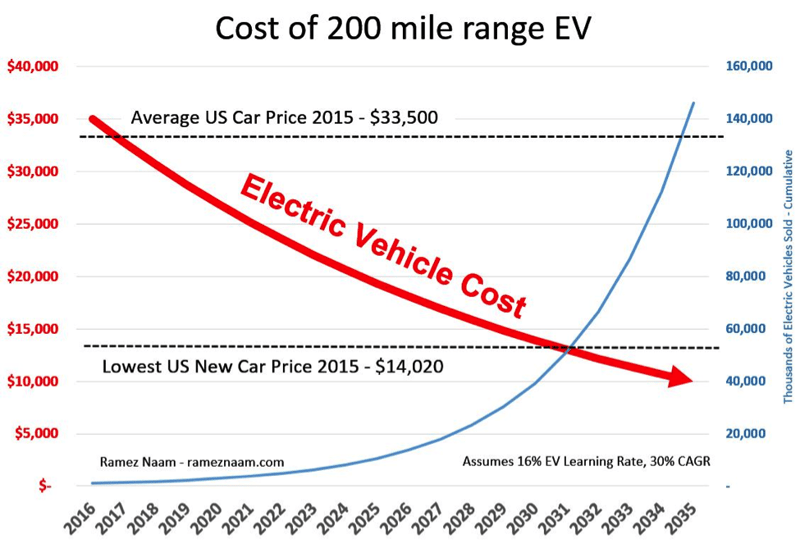
We are at the cusp of an energy revolution.
This blog is a look at how three technologies – solar, batteries and electric vehicles (EVs) – are poised to disrupt a $6 trillion energy industry over the next two decades.
I had the chance to sit down with Ramez Naam, the Chair of Energy & Environmental Systems at Singularity University and acclaimed author of the Nexus series, to discuss these major forces and their implications.
Let’s dive in.
P.S. Send any tips to our team by clicking here, and send your friends and family to this link to subscribe to Abundance Insider.
1. Creating an Abundant Solar Economy
In 88 minutes, 470 exajoules of energy from the sun hits the Earth’s surface, as much energy as humanity consumes in a year.
In 112 hours – less than five days – it provides 36 zettajoules of energy. That’s as much energy as is contained in all proven reserves of oil, coal and natural gas on the planet.
If humanity could capture 1 part in 1,000 (one-tenth of one percent) of the solar energy striking the Earth – just one part in one thousand – we could have access to six times as much energy as we consume in all forms today.
These staggering numbers, in combination with an exponential decline in photovoltaic solar energy costs ($ per watt price of solar cells), put us on track to meet between 50 percent and 100 percent of the world’s energy production from solar (and other renewables) in the next 20 years.
Solar is already undercutting coal and natural gas in sunny geographies.
Take a look at the plummeting costs…

(Graph: Decreasing price per watt of photovoltaic cells)
Over the last 30 years, solar module prices have dropped by a factor of 100.
Critically -- a new solar price record was set in Chile just a few weeks ago at $0.0291 per kWh – 58 percent less than the price of natural gas from a new plant!
And this is just the beginning. How cheap can it get?
The graph below shows that, if solar electricity continues on its current demonetization trajectory, by the time solar capacity triples to 600GW (by 2020 or 2021, as a rough estimate), we could see global unsubsidized solar prices that are roughly half the cost of coal and natural gas.

(Decreasing costs of solar electricity relative to other sources)
This is without factoring in the cost of air pollution and carbon pollution emitted by fossil fuel power plants.
2. Battery Technology is Reaching an Inflection Point
Of course, one limitation of solar is that it’s only available during the day. We’ll need breakthroughs in battery technology to transition fully into a solar economy.
The good news is that battery technology and energy storage are also hitting an inflection point.
Here are five trends shaping the future of battery technology and energy storage:
- Lithium-ion Technology: Lithium-ion batteries have been seeing rapidly declining prices for more than 20 years, dropping in price for consumer electronic uses by 90 percent between 1990 and 2005, and continuing to drop since then. This price reduction is coupled with an 11x increase in battery storage capacity per $100 since 2000.
- Scaled Production: The rollout of Tesla's Gigafactory makes $100 per kwh lithium-ion batteries in electric vehicles possible by 2020. This price point would yield an astonishing $0.11 per kWh electricity storage -- or, in other words, allow you to fill up the equivalent of a tank of gas for $9.35.
- Flow Batteries: Flow batteries are just starting to come to market and have been proven in the lab to operate for 5,000 charge cycles or more. This is a 10x improvement over standard consumer lithium-ion batteries.
- Compressed Air Storage: Companies like LightSail Energy are creating physical components rated for 10,000+ charge cycles.
- Time of Use Arbitrage: The U.S. is increasingly going to time-of-use charges for electricity. Right now that means charging consumers a low rate in the middle of the night (when demand is low) and a high rate in the afternoon and early evening (when demand is at its peak, often twice as high as the middle of the night).
These are just a few of the developments happening.
The real key here is that we are going to see a mindset shift in the near future. It will just be accepted that every home will be powered by a combination of batteries, rooftop solar and electric vehicles (i.e. Tesla's vision)… and we'll gawk disapprovingly at the idea of driving an explosive, expensive and environmentally damaging gas vehicle, and so on.
3. Electric Vehicles (EVs) Are Gaining Speed
Electric vehicles (EVs) are taking the transportation industry by storm.
Within the next two decades, EVs will undoubtedly be the cheapest and most widely used vehicles on the market.
Take a look at the chart below. By roughly 2030, EVs with a 200+ mile range are going to be cheaper than the cheapest car sold in the U.S. in 2015.

(Decreasing cost of EV from 2016-2035)
The primary factor driving this decreasing cost is that EVs are inherently simpler devices only possessing 10% of the moving parts of gasoline-powered vehicles (cheaper to build, cheaper to maintain).
Every major car manufacturer is working on electric vehicles – the number of EV models on the market has grown from 2 in 2010 to over 25 today.
Just four months ago, Tesla Motors shattered expectations with the biggest one-week launch of any product ever by taking 400,000 preorders for its $35,000 Model 3 (implying $14 billion in future sales).
Ford has followed suit, investing $4.5 billion in electric cars, and will be adding 13 electric cars and hybrids by 2020, making more than 40 percent of its lines electrified.
Bringing It All Together
The convergence of solar, energy storage and electric vehicles (EVs) creates a trifecta of disruptive forces hitting the energy industry over the next two decades.
Again, in 88 minutes, the sun provides 470 exajoules of energy, as much energy as humanity consumes in a year. Just think about this…
This raw energy combined with the economic feasibility of solar, advancements in energy storage, and the resurgence of the electric car will allow abundant cheap energy for everyone on the planet.
This is an incredibly exciting time for the energy industry, and an incredibly exciting time to be alive.
INTERESTED IN JOINING ME? (TWO OPTIONS)
- A360 Executive Mastermind: This is the sort of conversation I explore at my Executive Mastermind group called Abundance 360. The program is highly selective, for 360 abundance and exponentially minded CEOs (running $10M to $10B companies). If you’d like to be considered, apply here. Share this with your friends, especially if they are interested in any of the areas outlined above.
- A360 Digital Mastermind: I’ve also created a Digital/Online community of bold, abundance-minded entrepreneurs called Abundance 360 Digital (A360D). A360D is my ‘onramp’ for exponential entrepreneurs – those who want to get involved and play at a higher level.
Know someone who would benefit from getting Abundance Insider? Send them to this link to sign up.
P.P.S. My dear friend Dan Sullivan and I have a podcast called Exponential Wisdom. Our conversations focus on the exponential technologies creating abundance, the human-technology collaboration, and entrepreneurship. If you enjoyed this blog, listen to Episode 37: Living in an All-Electric Economy (released June 11, 2017). In this episode, I give a brief history of the energy economy and how humanity has transitioned from firepower to solar. Dan discusses his belief that technology is not replaced by another technology unless there is at least a 10X improvement. I also discuss my belief that car ownership is going to be dead by 2025, which means we no longer own a car, but instead own a “car as a service.”
Topics: Energy







